We want to say congratulations to the winners of the RSC poster prizes at the recent ACS Reaction Mechanisms Conference, hosted by University of British Columbia in Vancouver, Canada!
Juliet Macharia won the prize from Catalysis Science & Technology. Juliet is originally from Kenya and is now a fourth-year Ph.D. candidate in the field of organic chemistry at the Binghamton University in New York. Juliet says her career in science was led by curiosity. She wants to understand how and why things happen the way they do to provide a “path to illumination of the many mysteries of the universe.”

Juliet Macharia with her poster
Juliet’s current research focuses on the chemistry of a class of compounds called “arylboronic acids”. These molecules are widely used in fine chemical, pharmaceutical, agrochemical, and modern-material industries due to their stability, easy preparation and environmental benign nature. The key step in many reactions employing arylboronic acids involves carbon-boron (C-B) bond cleavage. Due to the relative inertness of the C-B bond, the in-situ generation of a more reactive ‘boronate’ species is considered to be vital to the success of these reactions. Her goal is to determine the exact mechanism of C-B cleavage in reactions using a physical organic tool, Kinetic Isotope Effects (KIEs) at natural abundance. In the future, she will utilize the mechanistic information from these studies for the rational design and development of new catalytic processes.
Anna Lo, who works with Professor Jared Shaw at UC Davis, was the winner of the Organic & Biomolecular Chemistry prize. She says that she decided to pursue a career in chemistry to take advantage of the creative thinking and liberty in the practice of organic synthesis.

Anna Lo
Anna’s work focuses on two goals: (1) to elucidate conditions that provide reliable selectivity for additions to a-chiral imines, (2) to develop a mechanistic rationale for the deviating selectivity trends her research group observes. Stereoelectronic models such as the Felkin-Ahn model and Cram’s rules have been used as powerful tools in the asymmetric synthesis of complex synthetic targets. Due to their robust utility, Felkin-control and chelation-control have been generalized to imine stereocontrol, despite fundamental differences in reactivity between N-substituted imines and their carbonyl analogues. Recent work has illuminated a class of a-chiral aldehyde derived imines that deviate from previously well-established stereoelectronic models. This illuminated a gap in understanding of existing stereocontrol models, specifically when applied to N-substituted imines, which Anna is now investigating.
This conference sounds like it was a great event, and we’re glad to support young researchers as they build their careers!










